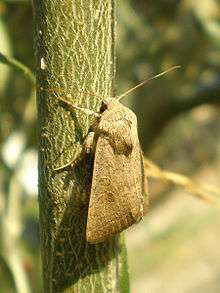Hoplodrina ambigua
| Vine’s rustic | |
|---|---|
 | |
 | |
| Scientific classification | |
| Kingdom: | Animalia |
| Phylum: | Arthropoda |
| Class: | Insecta |
| Order: | Lepidoptera |
| Family: | Noctuidae |
| Genus: | Hoplodrina |
| Species: | H. ambigua |
| Binomial name | |
| Hoplodrina ambigua Denis & Schiffermüller, 1775 | |
Hoplodrina ambigua, the Vine’s rustic, is a moth of the family Noctuoidea. It is found in the west Palearctic ecozone (Central Europe, South Europe North Africa, Russia to Urals, south west Siberia, Tuva, Altai Mountains, Tadjikistan, Turkestan and in the Near East - Iraq, Iran, Afghanistan, Pakistan).
Technical description and variation
The wingspan is 32–34 mm. The length of the forewings is 13–15 mm.Forewing greyish ochreous, sometimes uniformly washed with brownish; the lines and stigmata dark grey, the latter with pale annuli; submarginal line luteous preceded by a dark grey shade; hindwing dirty pale grey in male, darker in female, and darker in both sexes in the brown suffused forms: - the form sericea Speyer, from Holland and Germany, is described as having narrower silky grey forewings; -in [now full species levis Stgr.] , from W. Turkestan and Asia Minor, the yellower ochreous tint is predominant and the dark markings are conspicuous but in some pale examples from Segovia, Spain- ab. ochrea ab. nov. [Warren] the dark markings tend to become effaced, the head, thorax, and forewings being pale yellow ochreous - amurensis Stgr. indicates small dark examples from Ussuri, Amurland. [1] Similar to and confused with Hoplodrina octogenaria and Hoplodrina blanda. Certain identification requires dissection of the genitalia.[2]
Biology
The moth flies in two generations from early May to mid-October. .
Larva clay coloured, darker dorsally: the dorsal line itself fine and white with dark edges; the subdorsal also fine and pale; laterally a pale dark edged serrate line containing the spiracles. The larvae are polyphagous feeding on various herbaceous plants including Beta vulgaris, Cynara scolymus, Medicago sativa and Taraxacum officinale.[3]
Notes
- ^ The flight season refers to Belgium and The Netherlands. This may vary in other parts of the range.
References
- ↑ Seitz, A. Ed., 1914 Die Großschmetterlinge der Erde, Verlag Alfred Kernen, Stuttgart Band 3: Abt. 1, Die Großschmetterlinge des palaearktischen Faunengebietes, Die palaearktischen eulenartigen Nachtfalter, 1914
- ↑ Difficult Species Guide
- ↑ "Robinson, G. S., P. R. Ackery, I. J. Kitching, G. W. Beccaloni & L. M. Hernández, 2010. HOSTS - A Database of the World's Lepidopteran Hostplants. Natural History Museum, London.".
External links
| Wikimedia Commons has media related to Hoplodrina ambigua. |
- Lepiforum
- Funet Taxonomy
- Fauna Europaea
- Vlindernet (Dutch)
- waarneming.nl (Dutch)
- Lepidoptera of Belgium
- Vine’s rustic at UKmoths